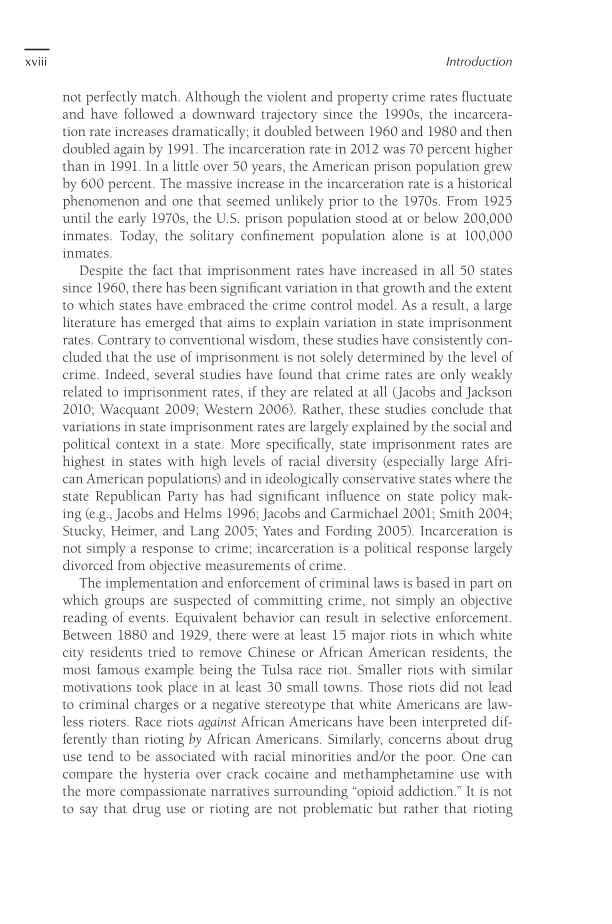not perfectly match. Although the violent and property crime rates fluctuate and have followed a downward trajectory since the 1990s, the incarcera- tion rate increases dramatically it doubled between 1960 and 1980 and then doubled again by 1991. The incarceration rate in 2012 was 70 percent higher than in 1991. In a little over 50 years, the American prison population grew by 600 percent. The massive increase in the incarceration rate is a historical phenomenon and one that seemed unlikely prior to the 1970s. From 1925 until the early 1970s, the U.S. prison population stood at or below 200,000 inmates. Today, the solitary confinement population alone is at 100,000 inmates. Despite the fact that imprisonment rates have increased in all 50 states since 1960, there has been significant variation in that growth and the extent to which states have embraced the crime control model. As a result, a large literature has emerged that aims to explain variation in state imprisonment rates. Contrary to conventional wisdom, these studies have consistently con- cluded that the use of imprisonment is not solely determined by the level of crime. Indeed, several studies have found that crime rates are only weakly related to imprisonment rates, if they are related at all (Jacobs and Jackson 2010 Wacquant 2009 Western 2006). Rather, these studies conclude that variations in state imprisonment rates are largely explained by the social and political context in a state. More specifically, state imprisonment rates are highest in states with high levels of racial diversity (especially large Afri- can American populations) and in ideologically conservative states where the state Republican Party has had significant influence on state policy mak- ing (e.g., Jacobs and Helms 1996 Jacobs and Carmichael 2001 Smith 2004 Stucky, Heimer, and Lang 2005 Yates and Fording 2005). Incarceration is not simply a response to crime incarceration is a political response largely divorced from objective measurements of crime. The implementation and enforcement of criminal laws is based in part on which groups are suspected of committing crime, not simply an objective reading of events. Equivalent behavior can result in selective enforcement. Between 1880 and 1929, there were at least 15 major riots in which white city residents tried to remove Chinese or African American residents, the most famous example being the Tulsa race riot. Smaller riots with similar motivations took place in at least 30 small towns. Those riots did not lead to criminal charges or a negative stereotype that white Americans are law- less rioters. Race riots against African Americans have been interpreted dif- ferently than rioting by African Americans. Similarly, concerns about drug use tend to be associated with racial minorities and/or the poor. One can compare the hysteria over crack cocaine and methamphetamine use with the more compassionate narratives surrounding “opioid addiction.” It is not to say that drug use or rioting are not problematic but rather that rioting xviii Introduction
Document Details My Account Print multiple pages
Print
You have printed 0 times in the last 24 hours.
Your print count will reset on at .
You may print 0 more time(s) before then.
You may print a maximum of 0 pages at a time.






































































































































































































